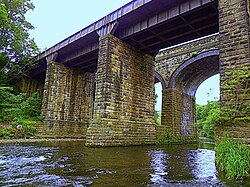
The Wharfedale line is one of the rail services in the West Yorkshire Metro area of northern England. The service connects Ilkley with Leeds and Bradford, and is operated by Northern Trains. West Yorkshire Metrocards are available for use on the line, covering Zones 3–5. The line is served predominantly by four-coach Class 333 electric multiple units.
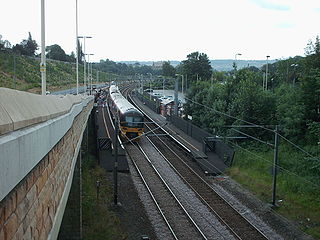
The Airedale line is one of the rail services in the West Yorkshire Metro area centred on West Yorkshire in northern England. The service is operated by Northern, on the route connecting Leeds and Bradford with Skipton. Some services along the line continue to Morecambe or Carlisle. The route covered by the service was historically part of the Midland Railway.

Bradford Forster Square railway station serves Bradford, West Yorkshire, England. The majority of services to/from station use Class 333 electric multiple units operated by Northern Trains; they run on the Airedale line to Skipton, the Wharfedale line to Ilkley and the Leeds-Bradford line to Leeds.
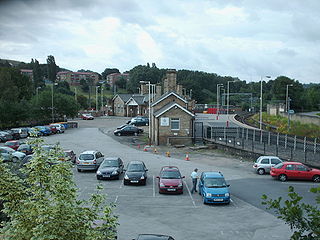
Shipley railway station serves the market town of Shipley in West Yorkshire, England. It is 2+3⁄4 miles (4.4 km) north of Bradford Forster Square and 10+3⁄4 miles (17.3 km) north-west of Leeds.

Frizinghall railway station is situated in the Frizinghall district of Bradford, West Yorkshire, England. The station, an unstaffed halt 2 miles (3 km) north of Bradford Forster Square is on the Airedale Line, and all trains serving it are operated by Northern Trains.

Saltaire railway station serves the Victorian model village of Saltaire near Shipley in West Yorkshire, England. It is situated 3+1⁄2 miles (6 km) north of Bradford Forster Square.

Bingley railway station is a grade II listed railway station that serves the market town of Bingley in West Yorkshire, England, and is 13.5 miles (21.7 km) away from Leeds and 5.5 miles (8.9 km) away from Bradford Forster Square on the Airedale line operated by Northern Trains.

Skipton railway station is a Grade II listed station which serves the market town of Skipton in North Yorkshire, England on the Airedale Line, which gives Skipton access to destinations such as Leeds, Bradford, Carlisle, Lancaster and Morecambe. The station is operated by Northern Trains and is situated 27 miles (43 km) north-west of Leeds.
The Leeds and Bradford Railway Company (L&BR) opened a railway line between the towns on 1 July 1846. It extended its line from Shipley through Keighley to Skipton and Colne, in 1847 and 1848.

Apperley Bridge station is situated in Bradford on the line between Leeds and Shipley, West Yorkshire, England. It serves the district of Apperley Bridge in the north-east of the city.
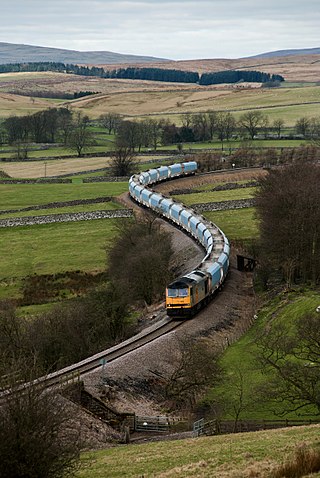
The Yorkshire Dales Railway was a branch line linking the town of Skipton with the villages of Rylstone, Threshfield and Grassington in North Yorkshire, England. There were two stations on the line - Grassington & Threshfield and Rylstone - and a connection via the Skipton to Ilkley Line to Skipton.

The Leeds and Bradford Extension Railway was an early British railway company in the West Riding of Yorkshire. It built a line from Shipley near Bradford through Keighley and Skipton to Colne. The Skipton–Colne Line closed in 1970, but the remainder of the line is still in use today, and once formed part of the Midland Railway's main line route from London to Glasgow.

Kildwick and Crosshills [sic] was a railway station off Station Road in Cross Hills, North Yorkshire, England. It served the villages of Cross Hills, Cowling, Glusburn, Kildwick and Sutton-in-Craven.

Kirkstall Forge railway station is a station serving the Kirkstall area of Leeds, West Yorkshire, England. It is on the Leeds to Bradford Line between Leeds City and Shipley and was opened on 19 June 2016, near the site of an earlier station with the same name.

The Otley and Ilkley Joint Railway was a railway line running between the towns of Otley and Ilkley in West Yorkshire. The line was managed and run jointly by the Midland Railway (MR) and the North Eastern Railway (NER) and was 6+1⁄2 miles (10 km) long. Opened to passenger traffic on 1 August 1865 and freight traffic some months later, the line ran for almost 100 years before partial closure in July 1965 when the line to Otley closed. Today passenger services run over the rest of the line as part of the West Yorkshire Passenger Transport Executive (WYPTE) Wharfedale Line.
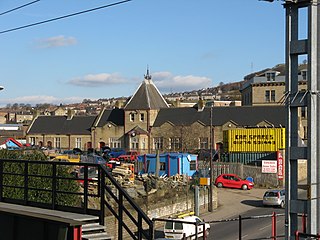
The Shipley Great Northern Railway branch line was a railway line that ran east, south and then westwards from Shipley to Bradford in West Yorkshire, England. The route was opened in 1874 to goods traffic and then to passengers in 1875 by the Great Northern Railway (GNR) and looped around the eastern edge of Bradford. The GNR arrived after other railways had been established in the West Yorkshire area and many of their lines were heavily reliant on tunnels and grand viaducts, the Shipley and Windhill line being an exception to this, although it did have some steep gradients. The branch extended for 8.5 miles (13.7 km) between the two terminuses of Shipley Windhill and Bradford Exchange. The route as built from Laisterdyke to Shipley was actually only 6.5 miles (10.5 km) as the initial section from Bradford Exchange to Laisterdyke was already in existence as part of the Great Northern Railway's line to Leeds.

Esholt Sewage Works Railway was a standard gauge works railway constructed in 1910 to serve a sewage works in Esholt, West Yorkshire, England.

Newlay and Horsforth railway station, until 1889 and from 1961 called Newlay station, was a station on the route of the former Leeds and Bradford Railway, located on the right bank of the River Aire and on the left bank of the Leeds and Liverpool canal between Horsforth in the north and Bramley in the south. It was accessed from Pollard Lane, which still crosses the railway on a bridge there, and served mainly the southern parts of Horsforth in West Yorkshire, England.

Thwaites railway station was a railway station located just east of Keighley, West Riding of Yorkshire, on the Midland Railway line through the Aire Valley between Keighley and Shipley. It opened to traffic in 1892 and closed 17 years later in 1909 due to poor patronage.
